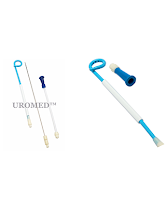Catheters; improving the quality of life
Percutaneous nephrostomy, PCN catheter is an almost indispensable piece of equipment in the medical intervention of any nephrostomy drainage. It is a generally and widely used piece of equipment in the diversion and decompression from the renal collecting system in many clinical conditions. Despite being a basic procedure in urology, it is technically great precision and the expertise of handling the equipment and inserting it correctly that makes the difference between success and failure.
Catheter manufacturers, Manishmedi, acknowledge the various procedures or methods that are employed in the effort to gain access. The ultra sound direct guided PCN tube placement is reliable and cost effective. Let us take a look at the different types of catheters.
 |
PCN catheter |
The Indwelling catheter: Is a catheter that is placed in the body and is expected to stay in place for an extended period of time. Inserted through the urethra, the ureteral catheter-indwelling is one kind. Another kind is the suprapubic malecot catheter which is inserted through the abdomen direct to the bladder. The long term indwelling catheters are usually changed every 30-60 days. Intermittent catheters: Are used “intermittently” as the word suggests and are placed into the urethra to drain the bladder, when that is done it is removed. The patient is trained on how to do this for them and is simple enough for most people. There are 2 types of intermittent urinary catheters in use, non-hydrophilic catheters and hydrophilic intermittent catheters. Non-hydrophilic catheters are uncoated catheters, and hydrophilic intermittent catheters are coated with an ultra-smooth surface to make insertion and removal easy.
Some indications for the use of a catheter:
1.when a patient has serious urinary retention or when the bladder outlet is obstructed.
2. The need for precise urine output in critical ill condition.
3. Patients undergoing urologic surgery or the genitourinary tract.
4. Patients slated to receive large amounts of diuretics in the course of surgery.
5. The necessity of intraoperative measuring of urine output.
6. in incontinent patients to assist in the healing of wounds.
Let’s look briefly at the material and structure of a catheter: Either silicone, latex or Teflon is used in the manufacture of the flexible tube structure of a catheter. The three broad categories of catheters are coronary, renal and infusion. Again broadly speaking catheters are used in cardiac, pulmonary, neonatal, CNS, and epidural tissues issues. They are also used for tissue removal and also are very useful as conduits in the use of optics and other surgical devices. Coronary catheters are used in the conducting angiography, angioplasty and in ultrasound of the heart. Since catheters are a product relating to human health, the quality control is stringent and uncompromising. Quality checks are a part of every step of the manufacturing process, and there is nothing left to chance. Today’s cutting-edge devices and technology are getting to more remote areas of the human form and are used to perform greater diagnostic and interventional procedures, demanding varying performance properties on the external and internal of the catheter process and along its length.


Comments
Post a Comment